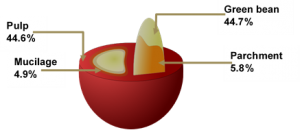Production of coffee pulp
With the production of coffee beans, coffee pulp is produced as well, since both are substituents from the same fruit.

Wet method
In the wet method, the cherries are collected and pulped fresh, leaving the mucilage (endocarp) and the silver skin attached to the beans. After pulping the beans go to fermentation tanks for a period usually in the range of 12 to 24 hours, in which the mucilage is released from the beans and silver skin. The beans are then dried (sun or hot air dried), the silver skin is removed and the green beans are packed and stored for further trade.
Dry method
In the dry method, the coffee cherries are dried, especially under the sun, for – in general – several days. Thereafter, the dried pulp is separated from the green beans by pulping. This method does not easily allow control of the drying process and may therefore generate a low(er) quality coffee.
The pulp problem
Most of the coffee nowadays is processed using the wet method with variations to lower water consumption and control over the drying process (semi-dry, natural pulping etc.). Nevertheless, relatively large amounts of biomass are still dumped once the coffee beans are separated from the coffee cherries. About 45% of the coffee cherry biomass is discarded. In other words: for every kilogram of roasted coffee that we consume, an equal amount of waste is left behind in the producing countries. This is a major problem of the coffee industry.
Regardless of the source (wet or dry processing), by-products and waste products from the coffee chain are often problematic. Pulp and mucilage are relatively acidic, corrosive to equipment, and hence difficult to safely dispose. Nowadays, most of the coffee pulp goes without treatment directly to huge waste disposal sites without any treatment. When this waste is dumped, it pollutes the environment in the coffee producing regions by leaching compounds into rivers, lakes and soil. The pulp and process water used to separate the mucilage from the bean in the wet milling factories have a high BOD (biochemical oxygen demand), which threatens water sources. Because the high contents of organic acids, caffein, cathechins, and tannins, the coffee pulp and process water pose a serious environmental problem in the regions where production takes place. The pollution generated from one ton of green coffee is equivalent to the pollution of domestic sewage output of 2.000 households. Furthermore, where the pulp is discarded in a landfill or other disposal site, rotting pulp may lead to unpleasant smells. Therefore, by-products and waste products from the coffee chain have often been viewed as materials which are either unusable, hazardous, or of negligible value.
Thus, coffee pulp is a challenge to the sustainability of the coffee supply chain. With the actual production of coffee reaching 10 million tons per year, technology to exploit this waste stream is necessary.
The pulp potential
Also for coffee pulp, composting is an alternative for disposal without treatment. However, big extensions of land and hard labor are necessary. The high biological and chemical demand of oxygen (B.O.D. and C.O.D.) make it almost impossible for the waste to start oxidation and fermentation to become compost. The high concentration of polyphenols makes of the use of this compost a poor fertilizer with the risk of poisoning the soil and making it acidic.
There has been research in the use of coffee pulp as feed for dairy cattle in Central and South Americas. Nevertheless, these practices use only a small percentage of the whole stream due to the anti-nutritional and toxic compounds in the biomass.
Fortunately, Pectcof technology can prevent the formation of waste, by transformation of the coffee cherries into its valuable bio-compounds, consequently detoxifying them.